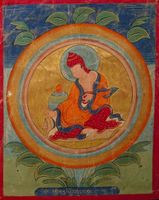Ratnākaraśānti
| PersonType | Category:Classical Indian Authors |
|---|---|
| MainNameTib | རིན་ཆེན་འབྱུང་གནས་ཞི་བ་ |
| MainNameWylie | rin chen 'byung gnas zhi ba |
| MainNameDev | रत्नाकरशान्ति |
| MainNameSkt | Ratnākaraśānti |
| AltNamesTib | སློབ་དཔོན་ཤནྟི་པ་ |
| AltNamesWylie | slob dpon shan+ti pa |
| AltNamesOther | Śāntipa |
| YearBirth | late-10th century |
| YearDeath | early-11th century |
| DatesNotes | Dates from The Princeton Dictionary of Buddhism, 2014. |
| ReligiousAffiliation | Vikramaśilā |
| TeacherOf | Maitrīpa |
| BDRC | https://www.tbrc.org/#!rid=P0RK153 |
| Treasury of Lives | https://treasuryoflives.org/biographies/view/Ratnakarasanti/23 |
| IsInGyatsa | No |
| BnwShortPersonBio | A circa 11th century Indian scholar that was one of the gate-keepers at the great monastic university of Vikramaśīla, as well as being included in the list of the eighty-four mahāsiddhas under the name Śāntipa. He was a prolific author and proponent of the Yogācāra school that was outspoken in his attempts to harmonize this school of thought with the philosophy of the Madhyamaka school. Though the majority of his known works, many of which were preserved in the Tibetan canon, covered topics related to Tantra. |
| PosAllBuddha | Qualified No |
| PosAllBuddhaNote | He accepts a pure nature that is the five wisdom's which are possessed, but obscured in sentient beings, but in terms of buddha-nature as a seed, only bodhisattvas have it. |
| PosAllBuddhaMoreNotes | "...he suggests that only bodhisattvas have Buddha-nature, that is, the spiritual disposition to become a buddha, whereas others do not." Kazuo Kano, Buddha-Nature and Emptiness, p. 75. |
| PosYogaMadhya | Yogācāra |
| PosYogaMadhyaNotes | There are apparently different takes on this issue, particularly whether he was a Yogācāran who accepted Madhyamaka or whether he was a Mādhyamika who accepted Yogācāra:
|
| PosVehicles | 3 |
| PosVehiclesNotes | Kazuo Kano, Buddha-Nature and Emptiness, p. 76. |
| PosEmptyLumin | Tathāgatagarbha as Mind's Luminous Nature |
| PosEmptyLuminNotes | "Ratnākaraśānti generally describes the tathāgata heart as being equivalent to naturally luminous mind, nondual self-awareness, and the perfect nature (which he considers to be an implicative negation and not a nonimplicative negation). As for the ontological status of mind, his Prajñāpāramitopadeśa says that it does not exist as apprehender and apprehended, but the existence of the sheer lucidity of experience cannot be denied." Karl Brunnhölzl, When the Clouds Part, p. 58. |
| Other wikis |
If the page does not yet exist on the remote wiki, you can paste the tag |

